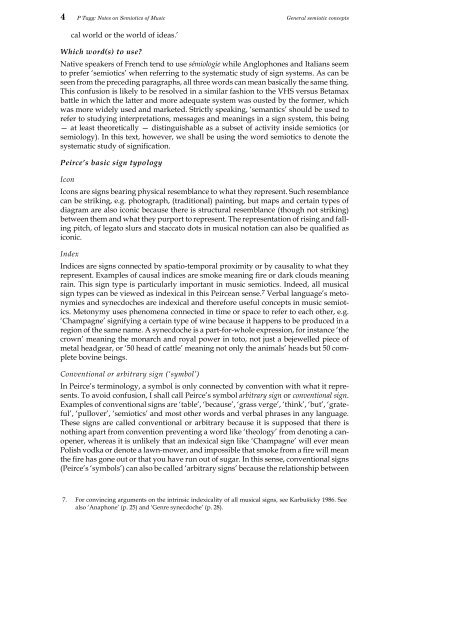Introductory notes to the Semiotics of Music - Philip Tagg's home page
Introductory notes to the Semiotics of Music - Philip Tagg's home page
Introductory notes to the Semiotics of Music - Philip Tagg's home page
Create successful ePaper yourself
Turn your PDF publications into a flip-book with our unique Google optimized e-Paper software.
4 P Tagg: Notes on <strong>Semiotics</strong> <strong>of</strong> <strong>Music</strong> General semiotic concepts<br />
cal world or <strong>the</strong> world <strong>of</strong> ideas.’<br />
Which word(s) <strong>to</strong> use?<br />
Native speakers <strong>of</strong> French tend <strong>to</strong> use sémiologie while Anglophones and Italians seem<br />
<strong>to</strong> prefer ‘semiotics’ when referring <strong>to</strong> <strong>the</strong> systematic study <strong>of</strong> sign systems. As can be<br />
seen from <strong>the</strong> preceding paragraphs, all three words can mean basically <strong>the</strong> same thing.<br />
This confusion is likely <strong>to</strong> be resolved in a similar fashion <strong>to</strong> <strong>the</strong> VHS versus Betamax<br />
battle in which <strong>the</strong> latter and more adequate system was ousted by <strong>the</strong> former, which<br />
was more widely used and marketed. Strictly speaking, ‘semantics’ should be used <strong>to</strong><br />
refer <strong>to</strong> studying interpretations, messages and meanings in a sign system, this being<br />
— at least <strong>the</strong>oretically — distinguishable as a subset <strong>of</strong> activity inside semiotics (or<br />
semiology). In this text, however, we shall be using <strong>the</strong> word semiotics <strong>to</strong> denote <strong>the</strong><br />
systematic study <strong>of</strong> signification.<br />
Peirce’s basic sign typology<br />
Icon<br />
Icons are signs bearing physical resemblance <strong>to</strong> what <strong>the</strong>y represent. Such resemblance<br />
can be striking, e.g. pho<strong>to</strong>graph, (traditional) painting, but maps and certain types <strong>of</strong><br />
diagram are also iconic because <strong>the</strong>re is structural resemblance (though not striking)<br />
between <strong>the</strong>m and what <strong>the</strong>y purport <strong>to</strong> represent. The representation <strong>of</strong> rising and falling<br />
pitch, <strong>of</strong> lega<strong>to</strong> slurs and stacca<strong>to</strong> dots in musical notation can also be qualified as<br />
iconic.<br />
Index<br />
Indices are signs connected by spatio-temporal proximity or by causality <strong>to</strong> what <strong>the</strong>y<br />
represent. Examples <strong>of</strong> causal indices are smoke meaning fire or dark clouds meaning<br />
rain. This sign type is particularly important in music semiotics. Indeed, all musical<br />
sign types can be viewed as indexical in this Peircean sense. 7 Verbal language’s me<strong>to</strong>nymies<br />
and synecdoches are indexical and <strong>the</strong>refore useful concepts in music semiotics.<br />
Me<strong>to</strong>nymy uses phenomena connected in time or space <strong>to</strong> refer <strong>to</strong> each o<strong>the</strong>r, e.g.<br />
‘Champagne’ signifying a certain type <strong>of</strong> wine because it happens <strong>to</strong> be produced in a<br />
region <strong>of</strong> <strong>the</strong> same name. A synecdoche is a part-for-whole expression, for instance ‘<strong>the</strong><br />
crown’ meaning <strong>the</strong> monarch and royal power in <strong>to</strong><strong>to</strong>, not just a bejewelled piece <strong>of</strong><br />
metal headgear, or ‘50 head <strong>of</strong> cattle’ meaning not only <strong>the</strong> animals’ heads but 50 complete<br />
bovine beings.<br />
Conventional or arbitrary sign (‘symbol’)<br />
In Peirce’s terminology, a symbol is only connected by convention with what it represents.<br />
To avoid confusion, I shall call Peirce’s symbol arbitrary sign or conventional sign.<br />
Examples <strong>of</strong> conventional signs are ‘table’, ‘because’, ‘grass verge’, ‘think’, ‘but’, ‘grateful’,<br />
‘pullover’, ‘semiotics’ and most o<strong>the</strong>r words and verbal phrases in any language.<br />
These signs are called conventional or arbitrary because it is supposed that <strong>the</strong>re is<br />
nothing apart from convention preventing a word like ‘<strong>the</strong>ology’ from denoting a canopener,<br />
whereas it is unlikely that an indexical sign like ‘Champagne’ will ever mean<br />
Polish vodka or denote a lawn-mower, and impossible that smoke from a fire will mean<br />
<strong>the</strong> fire has gone out or that you have run out <strong>of</strong> sugar. In this sense, conventional signs<br />
(Peirce’s ‘symbols’) can also be called ‘arbitrary signs’ because <strong>the</strong> relationship between<br />
7. For convincing arguments on <strong>the</strong> intrinsic indexicality <strong>of</strong> all musical signs, see Karbušicky 1986. See<br />
also ‘Anaphone’ (p. 25) and ‘Genre synecdoche’ (p. 28).














